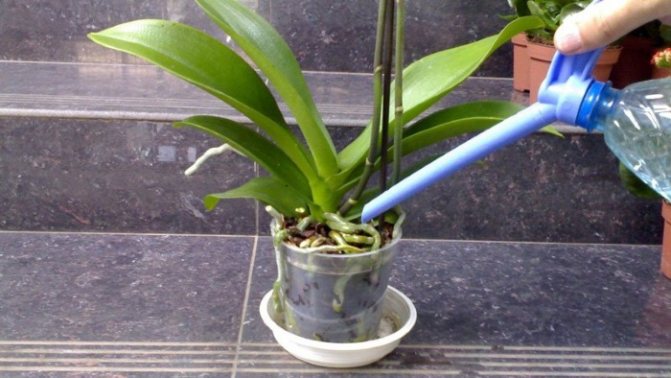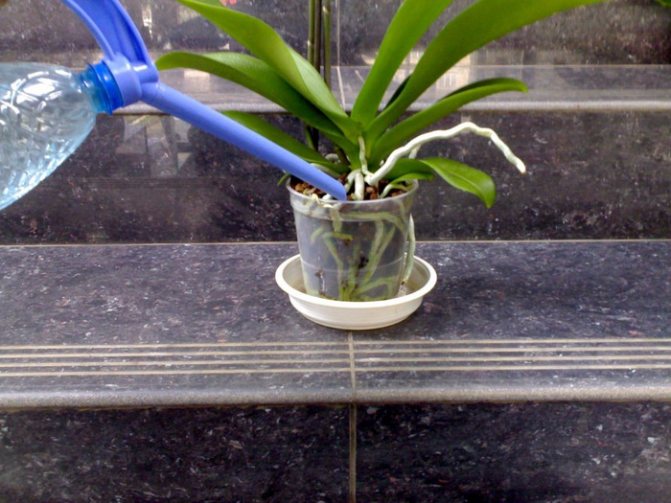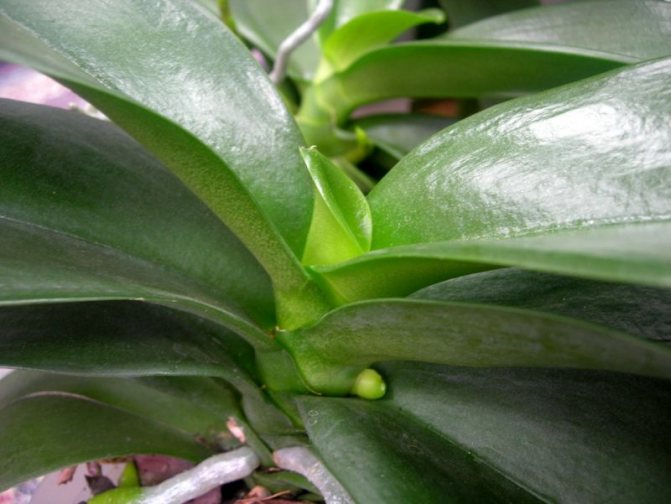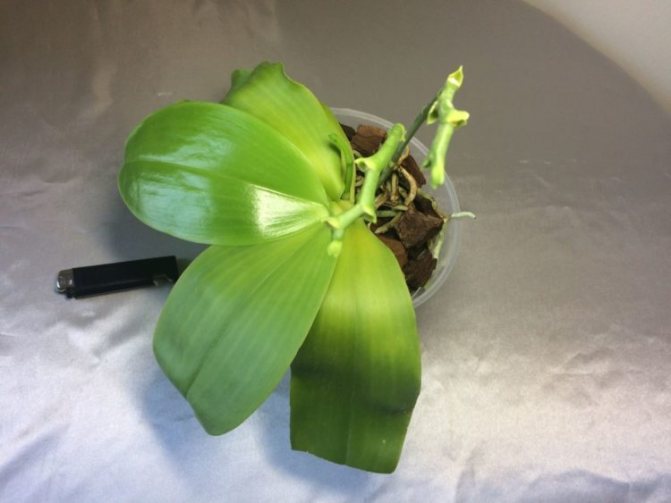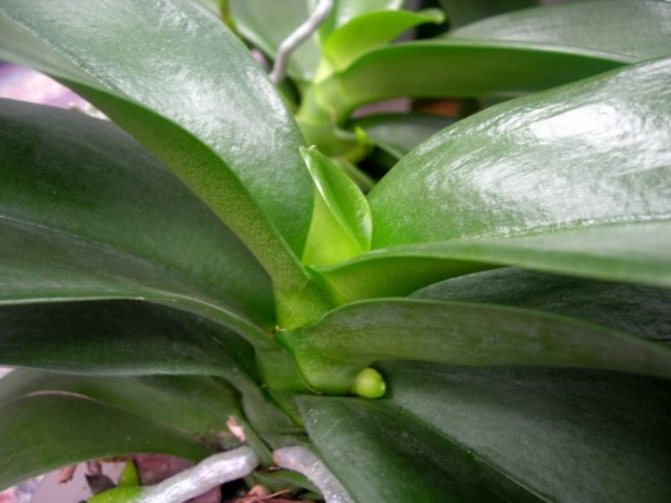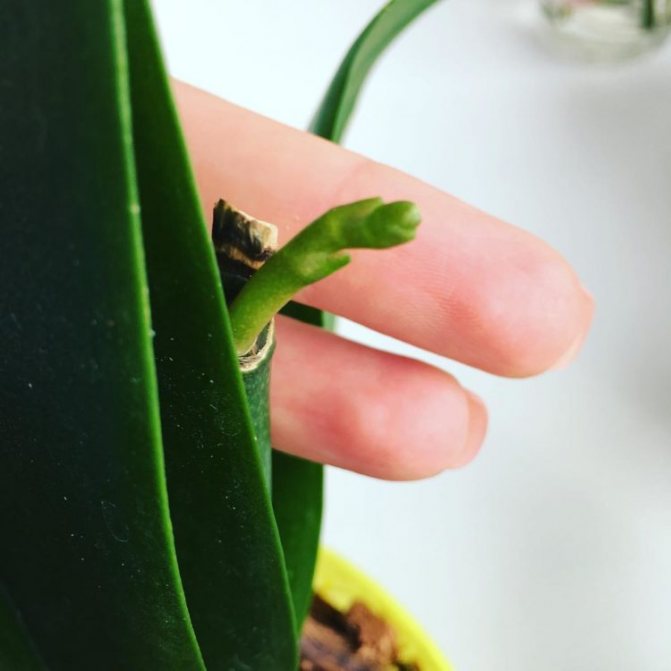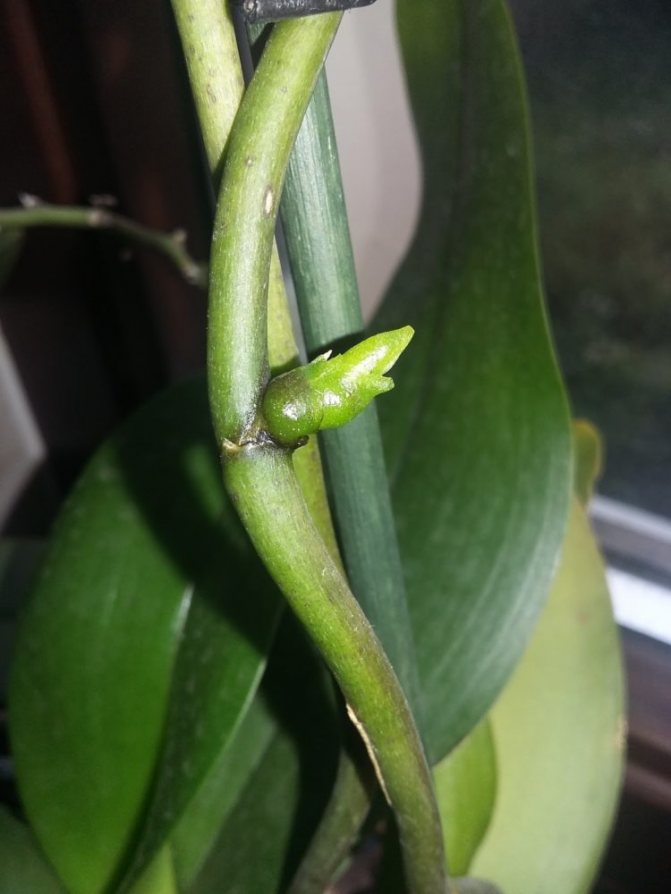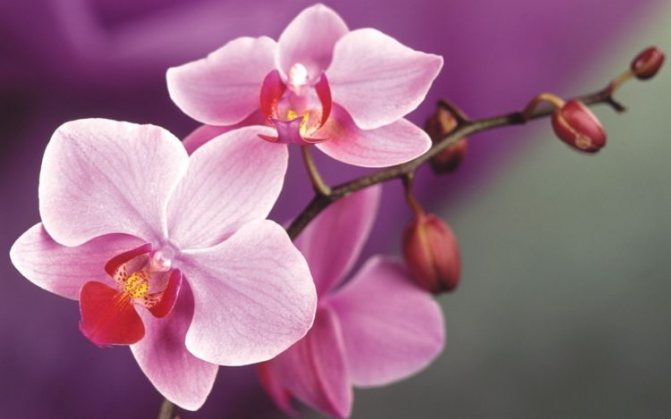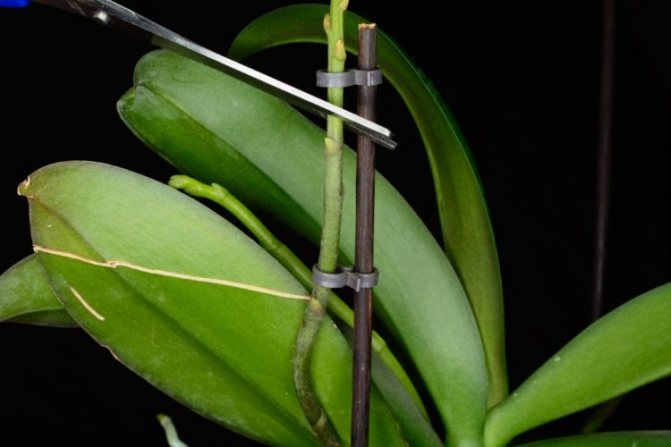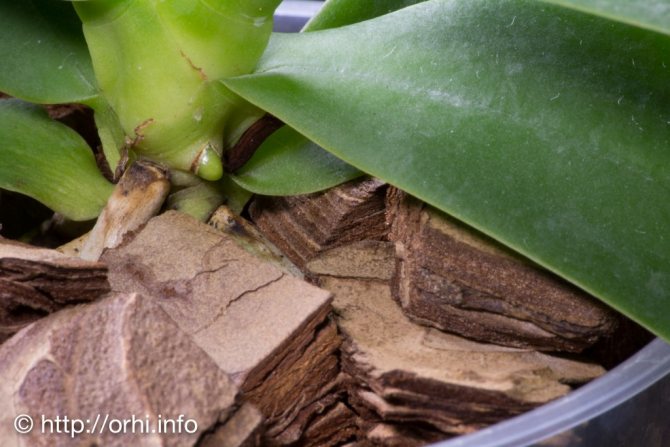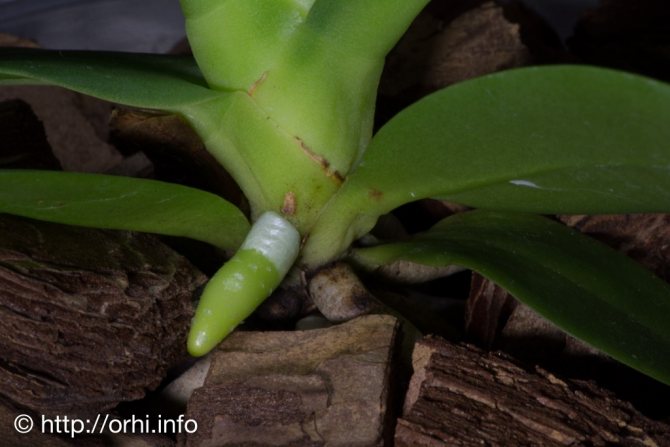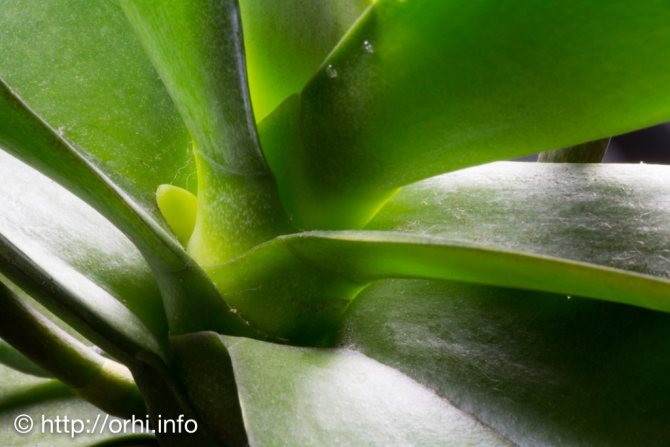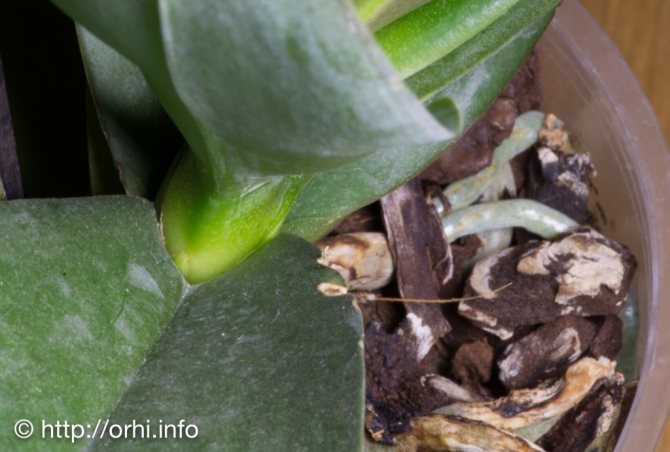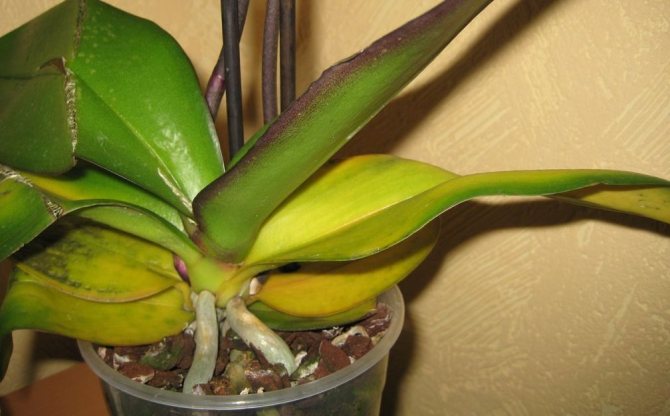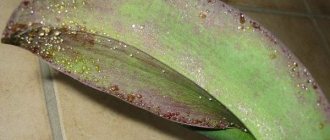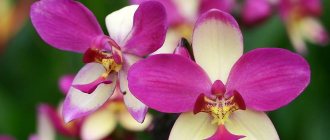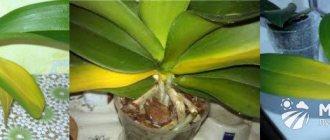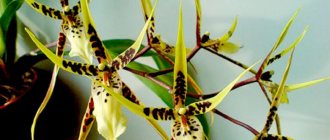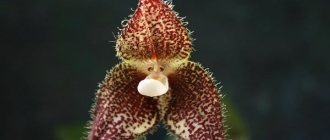The topic covered in the article is one of the most important and discussed among breeders and orchid lovers. The fact is that there are many reasons why the peduncle freezes.
Moreover, most of them arise from a banal oversight or annoying mistakes in care that could have been avoided.
As a result of such minor oversights, the exotic can be seriously damaged or even perish. In order to prevent disastrous consequences, you must adhere to a few simple rules.
- as a result of infection with the first disease, the edges of the leaves of the exotic are covered with whitish spots, and sticky dew forms on the back of the leaf;
- defeat by gray mold is accompanied by the development of dark mold at the base of the peduncle.
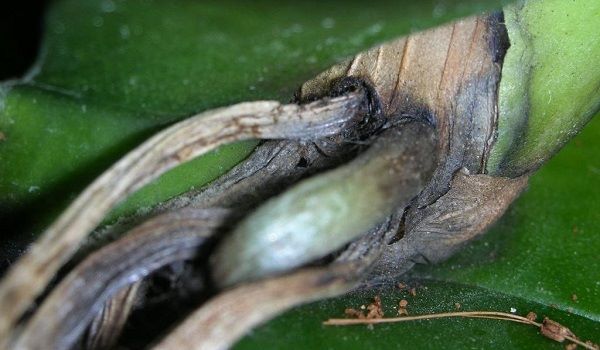
As a result of improper care, the peduncle may also stop developing.... In this case, it is worth checking whether the plant has enough sunlight and air humidity, how comfortable the room temperature is, and also exclude waterlogging of the phalaenopsis soil.
Appearance process
The appearance of a peduncle is always desirable, because what else can please a grower, if not a blooming stem on the windowsill.
With phalaenopsis in this regard, not everything is so simple, in order for the plant to start expelling the arrow some effort is needed.
And now a tubercle appears between the leaves, it grows every day and finally breaks through the leaf plate on the stem. But how to determine for sure that this is a peduncle, and not just another root?
There are no difficulties in this, just take a closer look at the neoplasm... Let us consider in detail how a peduncle appears in phalaenopsis:
Every day the arrow will grow and develop more and more actively, as a result, very soon you will be able to admire the flowering of a tropical beauty on your windowsill.


The development of the peduncle will end with lush flowering.
What if the phalaenopsis does not release a flowering shoot for a long time?


In the case when you can't wait for the phalaenopsis to bloom, follow simple rules.
- Increase lighting.
The orchid usually blooms twice a year. But if you want, you can force the plant to release an extraordinary peduncle by ignoring the dormant period. Ample lighting plays an important role here. Take care to find a place for the plant pot in a light enough spot. It is better to try to place the flowerpot on the east side of the room.Lighting should be not only abundant, but also long-term: up to twelve hours a day. If you will be using lighting bulbs to maintain this condition, keep in mind that simple bulbs will not work because they can overheat the orchid.
- Observe your watering schedule.
If you want to stimulate flower stalk release, limit watering. Let the plant rest for ten days, and only then moisten the soil. The best way to water is with a shower.To do this, put a flowerpot with phalaenopsis in the bathroom and pour plenty of water on top (but water the flower only with settled water).In the described way, you will kill two birds with one stone: water both the upper and lower roots, and also carry out hygienic procedures. If ten days have passed and the roots are still green, then you still shouldn't water the plant. The same situation is with condensation on the walls of the flowerpot. If there is one, there is no need to moisten the soil.
- Provide a comfortable temperature.
The most important condition is the difference between day and night temperatures (normally it should be 4-5 degrees). High temperatures stimulate the growth of only the leaf mass, but not the peduncles. The comfortable temperature is about 20-21 degrees above zero during the day. - Correct fertilization.
To get the flower arrow thrown out, you need to feed the plant well. You can resort to pharmaceutical preparations such as succinic acid or Zircon. Dilute it according to the instructions on the package.
You can find out why an orchid does not release a peduncle and how to get it to do this.
Difference from root baby
Experienced flower growers know that in addition to roots and peduncles children can develop on orchids. Sometimes they appear on peduncles, but under a certain set of circumstances, children can develop in other places.
One of these places is its root location.
The phalaenopsis arrow and the baby have one place of growth, they tend to develop from the leaf sinuses, and at the very beginning of development, they are visually very similar. It manifests itself in the form of an escape, and in color, and in the presence of scales.


The appearance of a baby, including a root one, is usually preceded by such indicators:
Each of these signs indicates that a baby will appear at the trunk in the near future. Moreover, the absence of a growth point is most often characterized by the appearance of a basal sprout.
But besides the similarity, these two neoplasms also have a number of differences. How to distinguish a peduncle from a baby:
Based on this, it will be possible to determine what grows in the orchid.
What if the arrow appears but does not grow?
In a situation where the peduncle still came out of the leaf sinus, but for some reason stopped developing, observe the conditions of keeping your beauty.
- Increase the abundance and frequency of soil moisture. The orchid needs to be fed, so water it often.
- Put the flowerpot with the plant in the brightest place, which is in your premises. Light is the most important factor in the growth of the peduncle.
After changing these factors, the peduncle should go into growth. If it doesn't, try changing your nutrient mix.
Useful videos
Watch the video, what is the difference between orchid peduncles and roots: The video illustrates the nuances of the difference and gives some tips for care: In this video, you can see how the phalaenopsis peduncle grows: The video tells how to distinguish a peduncle from a baby:
Distinguish the root from the baby in the phalaenopsis orchid not difficult... It is enough just to take a closer look at the neoplasms and wait a little, time will put everything in its place.
Photo
Below you can see a photo of the phalaenopsis orchid and see how and from where he releases a flowering arrow.
Root or peduncle?
- appears strictly from the stem, where the central vein of the leaf passes;
The peduncle of the phalaenopsis appeared.
- directed straight up;
- grows from anywhere in the stem, even from the center, where the central vein of the leaf passes;
Phalaenopsis root.
- more often directed downwards, but can look both sideways and upwards;
Actively growing phalaenopsis root.
- the tip of the root is rounded, not far off the light velamen is visible;
Growing root in phalaenopsis.
Step-by-step instructions: what to do in a certain situation?
Consider what to do if the peduncle that grows from the point of growth is broken or other possible cases:
- Grows from a point of growth. This happens if the phalaenopsis has already undergone many flowering cycles or experienced severe stress. In this case, you do not need to take any action, you just need to take care of the plant and, perhaps, buds or children will appear on the arrow.
- Broken. In this case, you need to cut the peduncle to the bud located closest to the fracture site and treat the cut site with crushed activated carbon, wood ash or cinnamon powder.
In simple language about how to distinguish a root from a peduncle in an orchid


The most beautiful thing about indoor orchids is their bloom. Unfortunately, it sometimes takes a long time to wait for this period. And finally, a peduncle that appears is easy to confuse with a root or a baby. What does a peduncle look like?
How is it different from a new root or baby? And the most important thing is how to care for the plant while the peduncle is developing, we will tell you in detail in the article. We also recommend watching a useful and informative video on this topic.
Formation period
How quickly is it formed?
Consider how long the peduncle grows in the indoor phalaenopsis orchid. The average time of its formation in an ordinary phalaenopsis is two months, in a hybrid one - three. This is how much time must pass after the appearance of the stem before the peduncle is fully formed. If the plant is in comfortable temperature conditions for it, receives the required amount of light and moisture, then this time will decrease by 1.5-2 times.
The lateral peduncle develops faster - in about 1.5 months.
How many arrows does it shoot?
The most common phalaenopsis, which has 2-3 peduncles, but there are also specimens with a large number of flowering shoots. At home, the number of arrows depends on the type of phalaenopsis, its health and the care provided.
general information
The peduncle of an orchid is a shoot on which flowers are formed... One peduncle can have more than 50 buds! But this is in an adult and large orchid. The peduncle looks like a long and flexible stem, on which subsequently, after it grows to a certain length, orchid buds will begin to bloom. Some growers use the term "peduncle" in a narrower sense and understand by it the area of the stem of the plant, on which the flowers are directly located.
The main rule is that the peduncle always grows from the point of growth.
How to avoid fading
Sometimes, instead of flowers, babies are formed on the orchid. The main reason for this is non-compliance with a comfortable temperature regime during the winter period.
There may be another problem: the root system may be damaged. The plant has nothing to eat, and in order for life to continue, the flower raises its children higher into the air space, in which there is no waterlogging. And then it turns out that instead of blooming, the orchid produces healthy offspring.
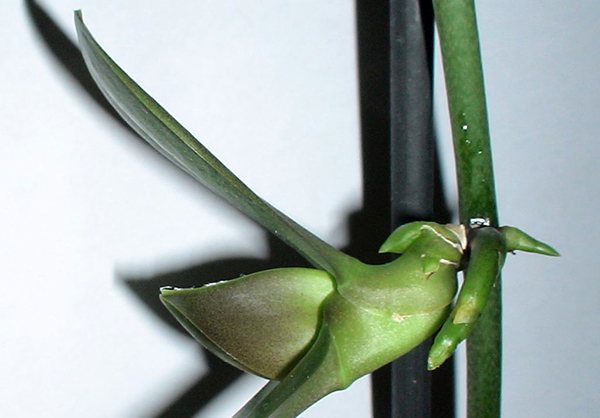

As soon as the babies give roots, they can be removed and rooted in the ground.
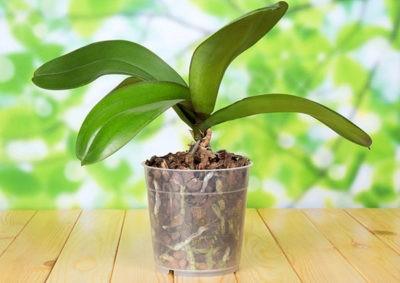

It often happens that your beautiful orchid has beautiful fat leaves, good roots, but you still can't wait to bloom. This is due to the vital activity of such a "organ" of a plant as a peduncle.
In this article, we will tell novice florists about what a peduncle is in an orchid, what function this part of the plant performs, as well as what to do if an orchid does not have this shoot and what to do to make it shoot a peduncle twice at home. ...
Let's talk mainly about such a type of orchid as Phalaenopsis, because it is the most common in our country, as it is the least whimsical to care for.
Why is it important to determine what kind of new shoots a plant has?
Whatever appears in an orchid, for a grower who loves his plant, it is always a joy. A new root, a baby, or a flower stalk promising a lush bloom is equally good. But it is still worth distinguishing the peduncle from other parts.


Thus, you will understand that the plant needs to be looked after more carefully. After all, the orchid during the flowering period requires special attention, periodically - feeding. The irrigation schedule is also changing.
How to stimulate the appearance
The best time is when the orchids throw out their gorgeous flowers. But it often happens that this period must be waited for a long time. Therefore, if the plant does not bloom for a long time, then stimulation of the flowering shoot can be undertaken. This simple procedure includes several tricks. It should be noted that the flower cannot be transferred to the flowering phase if a comfortable temperature regime has not been created.
All growers like the flowering period, but not everyone knows how to get an orchid to release a peduncle. In order for the plant to drive out the flowering shoot, you need to subject it to a little stress. For example, create conditions for the onset of artificial drought. To do this, reduce the amount of watering, or stop watering altogether after flowering. Sudden changes in temperature can also be created. All these processes are best done in winter.
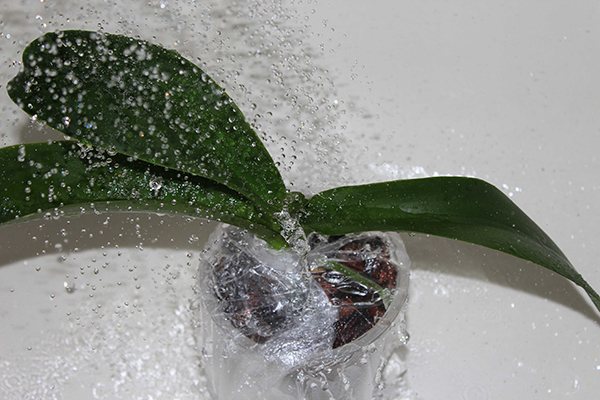

What does he look like?
Throughout its life cycle, the peduncle is greatly modified. It can be of two types.
It usually sprouts from the leaf axils - the place where the leaf comes close to the stem. It breaks through the leaf. The peduncle is usually flat in shape, but with a pointed tip that has a stepped shape... It is light green or deep green, growing upward or sideways, heading towards the sun.
Gradually, the hatching peduncle will grow, turning into a long flexible stem, juicy and green. Then buds will bloom on it. Orchid flower stalks are very fragile and easy to break.... So it is better to tie the peduncle as it grows.
When the orchid fades, the peduncle will begin to change: it will change color to yellow or brown. Sometimes the color can even change to red or bright purple. After that, the old peduncle dries up and disappears. But it is better not to bring it to this, and cut off the peduncle immediately after the last flower wilts - this way you will save the plant's strength.
But sometimes it is difficult to understand if the flowering period has already ended.... Pay attention to the tip of the stalk. As long as it is green, this indicates that it is growing, it can increase in size and release new buds. But if the tip turns yellow, blackened or dried out, the flowering has come to an end.
To trim or not trim the peduncle - you can decide individually. The fact is that an old peduncle can bloom again or form a baby. On the other hand, old peduncles inhibit the development of new ones and generally weaken the plant.
Why did the orchid's peduncle stop?
First of all, the gardener needs to comprehend what and why he does in caring for a tropical pet? The fact is that with a detailed analysis even the most harmless manipulations in caring for an exotic can be harmful and even dangerous for their development and growth.
Analysis of conditions of detention
When purchasing a phalaenopsis or other orchid for his flower garden, each grower must not only own, but also properly dispose of knowledge about the specifics of growing and keeping these exotic plants at home.
The most important care factors are:
Lighting
These exotic flowers love bright, but diffused light... In their natural habitat, daylight hours can last up to 12 hours. The same lighting regime must be adhered to at home.
With room keeping exotic daylight hours from 10 to 12 hours considered quite acceptable and quite feasible condition in the spring-summer period.
It is much more difficult to maintain the light regime in winter and autumn, since the illumination with the onset of cold weather also becomes less. In this case, it is necessary to save the plant from drying out. with artificial light.
For these purposes, flower shops sell special fluorescent lamps, with which it is enough to highlight only the tip of the peduncle, and not the whole plant. Illumination with such a device should be carried out for 12 hours.
Difference between night and day temperatures
A comfortable and safe growing of orchids is only possible at well-defined temperatures. Otherwise, the flower may get sick or die. The temperature in the room where the flower is located should be +20 - + 25 degrees Celsius.
The lowest possible temperature at which the orchid can grow and develop normally, should not be below +18 degrees... Sometimes, if the phalaenopsis stops blooming, it is possible to artificially create a stressful situation for it by lowering the temperature regime to +16, but this method is allowed to be resorted to only in exceptional cases and in no case should such stress be constantly practiced.
A strict rule of watering
The very first rule for every gardener is regular watering green favorites. But in the case of orchids, this is a special ritual.
Watering this tropical flower is essential at least 3-4 times a month during the heat, and at least 1-2 times during the cold season.
In addition, it must be remembered that it is very easy to overmoisten the orchid substrate and thereby cause significant damage to the plant. Most often this happens as a result of uncontrolled irregular watering.
Air humidity
Regardless of the fact that orchids are native to the rainforest, many of them still do not like too high humidity. On the contrary, these exotic plants easily adapt to a moisture content of -50%. The maximum comfortable humidity for them should not exceed the mark - 70 percent.
Also among the varieties depending on the percentage of moisture, there are:
Top dressing
The most favorable for the introduction of fertilizers and dressings is precisely the period of growth of both the peduncles themselves and the plant as a whole. It is important to remember that it is recommended to introduce fertilizers no more than 1-2 times a month alternately with ordinary watering.


Fertilizer for orchids is always administered along with watering.
Wherein feeding is best with liquid fertilizers and suspensions, since the structure of the substrate is not adapted to the dissolution of tablets and capsules.
Influence of harmful insects on arrow growth
Some types of insects also have a negative effect on the growth of the flowering arrow of an orchid. Among the most dangerous pests are mealybug, scale insects, aphids, spider mites and bulb mitesas well as some others.
How to distinguish from a root?
A newly hatched peduncle can be easily confused with a root or baby. Focus on the following differences:
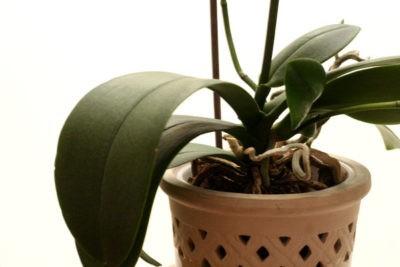

Peduncle:
- It appears strictly from the neck of one of the freshly formed leaves.
- It often grows outside, rather than in the leaf axils. It can grow from anywhere on the neck of the orchid, including from the middle of the leaf.
Watch a video about the difference between a peduncle and an orchid root:
How to achieve flowering?
If the orchid does not bloom for more than six months, the peduncle froze, and instead of flowers, leaves began to actively grow - this is an indicator busting with dressings... The fact is that fertilizers promote the growth period.
If you overdo them, you can provoke an accelerated flowering - a phenomenon when the buds dry out and fall off without blooming. In this case you need to stop giving exotic food for at least a month.
If the orchid has not bloomed for a long time, you can try to provoke her artificial shock... For example, create a temperature difference from room temperature + 20-25 degrees to + 16-17 degrees by moving it to the balcony. The main thing in this business is not to overdo it and not freeze the pet.
If, instead of flowers, children appear on the peduncle, then the orchid is already mature enough and ready to breed. It may also indicate the process of pollination. In this case it is necessary to prepare for the transplant of a young sprout.
How is the peduncle different from the baby?
What does the baby look like:
It is almost impossible to distinguish a peduncle from a baby... It is necessary to wait until the process increases to at least 3 cm, then it will already be possible to understand something by the shape of the tip. The ability to instantly recognize what your orchid is growing comes with experience.
Watch a video about the difference between a baby and an orchid peduncle:
Features of care during growth
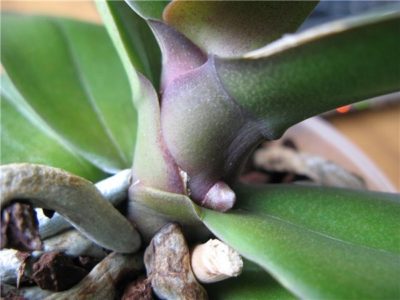

The growth period of the peduncle is a very important moment in the life of an orchid, when it is especially important to provide her with good care.
- It is necessary to provide the plant with good lighting. Daylight hours for the phalaenopsis that released the shoot should be at least 12 hours. In autumn and winter, you need to put a flowerpot with an orchid on the window sill on the south side of the room, and if this is not possible, you should use a phytolamp for additional lighting.
- The humidity must be kept at an optimal level, to do this, you can use a humidifier or place a container of water next to the orchid. This is especially important in winter when the indoor air is too dry.
- It is imperative to feed the plant with fertilizers, which contain a lot of phosphorus and potassium from the moment the peduncle just began to form and before the flowers appear on it. After the flowers appear, feeding should be suspended, as this will not increase the splendor of flowering, but it can provoke a drop of flowers.
- Watering is done as usual - as the soil dries out. The regularity is individual for each specific case, as it depends on the temperature and humidity of the air. Phalaenopsis with a regrown peduncle does not need direct spraying, rather it will destroy the sprout. It is enough to put a flowerpot with an orchid between other plants during spraying and it will have enough moisture.
Video about caring for phalaenopsis during the period of peduncle growth:
How to care?
After the release of the peduncle, the orchid can bloom for up to a year, gradually increasing it, and dissolving bud by bud.In another scenario, many flowers will open at the same time on the orchid, which will soon wither.
You can prolong flowering by competently caring for the peduncle:
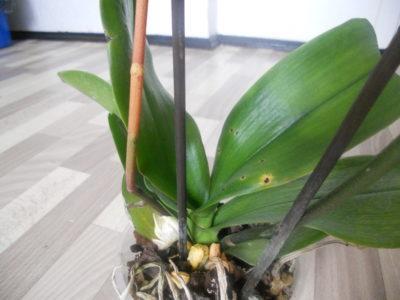

Do not allow the peduncle to remain in a draft. Cold and warm air is equally destructive for it, so put it aside from the battery and the air conditioner. An orchid that has stood in a draft for a day can throw off all flowers.
Watch a video about caring for an orchid with a peduncle:
How to deal with drying out?
First you need to figure out the reasons for this.
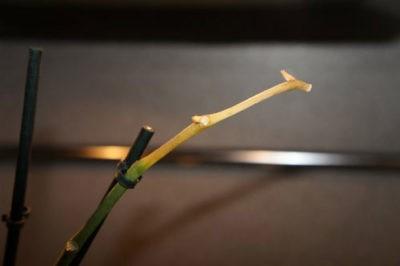

Bad light.
First, it may not be enough. Of course, this is natural when there is less light in the autumn-winter period, but you should still extend the duration of the lighting to at least 8-9 hours a day.And secondly, the correctness of the lighting. Many inexperienced growers, trying to provide the plant with uniform illumination, twist the flower pot. This is a gross mistake. The orchid regards such actions as stressful. Therefore, fix the position of the phalaenopsis in relation to the light and try not to change it.
- Incorrect temperature readings.
Ideally, the temperature in the room should not drop below fourteen degrees above zero and should not rise above thirty (less often - 35) degrees Celsius. Also, do not overdo it with airing the room, especially in winter. Both high and low temperatures lead to wilting of the buds, and then to the drying of the peduncle. - Dry air.
This factor has a very negative effect on the whole plant. At first, you will notice a deterioration in the general tone of the flower arrow, and then its complete drying. - Lack of nutrients.
Elements such as magnesium, potassium, phosphorus and boron must always be in the soil. Therefore, regularly add them to the soil, but this does not need to be done separately for each element, but with a ready-made complex purchased in the store.There are times when drying of the peduncle is inevitable. This happens when all the buds have bloomed on it. In this case, wait until it dries completely and cut off the flower arrow, leaving a couple of centimeters. Do not forget to treat the cuts with crushed charcoal or cinnamon.
In most cases, a drying peduncle can be saved. Review the conditions for keeping the plant as a whole and change them while it is still possible.
Read more about why an orchid's peduncle can dry up and what to do about it here, and from this article you will learn about what an orchid baby is and how to grow it on a peduncle.
Today we introduced you to the structure of the orchid, or rather, to its specific part - the peduncle. This area of the plant is as important as the root system. and sheet plates. Therefore, their care must be appropriate.
Without your help and full-fledged, and most importantly, correct, care, buds will not appear on this flower arrow, which are able to open and remain blooming for a long time. If you adhere to very simple rules for caring for an orchid, it will attract the eyes of your guests with its flowering for a long time.
Thought it was a phalaenopsis peduncle, or was it a baby growing up?
Garden lighting - according to all the rules There are quite a few lighting options and each gives its own effect. The most common ones are lighting of building facades, lighting up to.
Abramtsevo bouquet In the year of the 170th anniversary of I.E. Repin Museum-Reserve "Abramtsevo" held an unusual musical and floral celebration.
Double-sided flower garden When planning such a flower garden, it is necessary to be guided by the dimensions of the plants, the peculiarities of their development and the requirements for the conditions.
More details
Time and place of appearance
A stem appears on which flowers will grow in the axils of the leaf plates. The bosom is the angle between the stem and the leaf. This is where the flower bud is laid.
The most favorable season for the growth of new shoots is autumn. New leaves usually appear in summer.
The period from the beginning of the growth of the peduncle to the opening of the buds takes about two months. The duration of growth is influenced by illumination: the more light, the faster the growth process will progress.
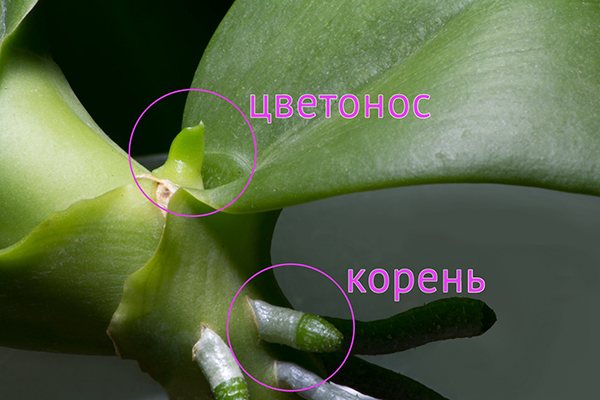

Note that the lateral stem is formed much faster: beautiful flowers will bloom in a month and a half, and in some cases even after a month.
How to distinguish a peduncle from a root in an Orchid?
Usually, it is not difficult for an experienced florist to distinguish a peduncle from a root, but for novice orchid lovers it is a real secret.
The peduncle always appears in a certain place - strictly from the stem of the plant, where the central vein of the leaf blade passes. The root, unlike the peduncle, can appear anywhere. The peduncle is directed upward, and the root is most often downward, but it can also be to the side, and also, at first, upward. At the tip of the peduncle, a formation is visible, which in its shape resembles a closed beak. The root tip has the usual rounded shape.
On orchids, there is another mysterious formation - a root baby. By all indications, it resembles the growth of a peduncle, but its tip looks like an open beak.
More details
How to make it grow up?


The flower arrow can grow in a very unusual way - even bend into a pig's tail. But more often than not, you shouldn't worry about it. Any living creature is very intelligent and has a high level of survival. therefore the orchid itself directs the peduncle upward to extend its life.
But it happens that the shoot stubbornly grows down. Then the whole responsibility falls on the grower. You need to start acting while the flower arrow is still young and malleable for any mechanical damage. To do this, you need to tie up a young shoot with wire and attach it to a holding stick.
The second option for changing the direction of growth of the flower arrow is to adjust the angle of incidence of light on the plant. Lighting should be set so that the peduncle stretches upward towards the sun. It may also happen that no maneuvers will help, and the process will continue its growth downward. If you find yourself in a similar situation, humble yourself and put the orchid pot in such a place so that the peduncle can grow freely in the opposite direction. Yes, this is strange and unusual, but it can be.
Orchid. How to distinguish in an orchid where the roots came out, and where is the peduncle?
ROM @ SHKA
Sage (10492) 5 years ago
The roots are round and smooth, and at the peduncle the tip is slightly pointed.
Marina Anatolyevna
Artificial Intelligence (141693) 5 years ago
peduncle of the same color. like the leaves, and the roots are lighter, the skin is slightly wrinkled. and the peduncle will grow evenly with an arrow, and the roots are rather winding
Elena
The Thinker (6055) 5 years ago
The peduncles and roots of orchids are similar only at first glance. Difference in color (the former are brighter, the latter are muted tones). Specifically, in phalaenopsis: peduncles are green, roots are green-silvery. The tip of the peduncle looks like a small beak (it contains flower buds). and the root tip is rounded. And yet - the roots are thicker than the peduncles. After the orchid gives the first peduncle, there will be no doubt.
A source:
Personal experience
More details
Follow these 9 rules and your orchid will bloom all year round
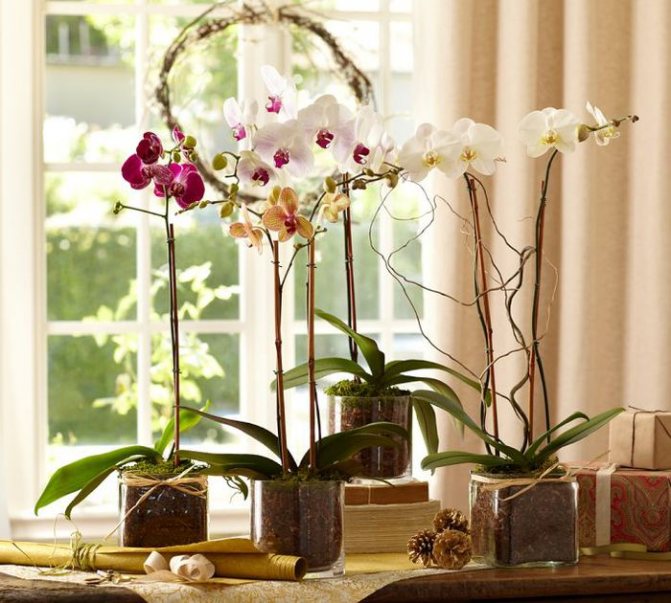

Looking at a blooming orchid, many growers do not even think about buying this extraordinary plant or not. Buy, of course! But will it bloom just as well at home?
Everyone knows that the orchid is a rather capricious plant and requires meticulous care. You can achieve re-flowering from it if you know all the factors contributing to this and follow a certain care regimen. Then the flowering of the orchid will last from 2 to 6 months. And some genera, like Phalaenopsis or Wanda, can bloom all year round.
The frequency of flowering of an orchid depends on the observance of certain rules of care. In order for a plant to bloom, there are 9 important conditions to remember.
1. Find out the age of the orchid
If you bought a non-flowering plant and it is in no hurry to please with a flower arrow, it may be too young. Different types of orchids bloom at the age of 1.5 to 3 years. To determine if the orchid is old enough, you need to count the number of shoots. An adult plant, ready to bloom, should have from 5 to 8. If flowers appear on an orchid earlier, this is not always good. The fact is that a plant that is too young may not have enough strength to recover from flowering, and the orchid may die.
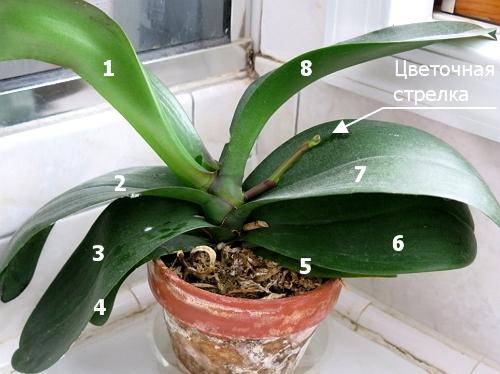

2. Don't move the pot
Many people know that moving for an orchid is a real stress. But this flower does not like even minor movements. The orchid reacts to position in relation to light. Therefore, if there is a need to rearrange a pot with a plant, it is necessary to place it on the same side to the light source as it was before. Also, do not move the orchid while watering. Movement adversely affects the growth of the flower, especially at the time of the appearance of the peduncle.
3. Pay attention to the roots
As you know, the roots of orchids are actively involved in the process of photosynthesis, so it is important to ensure that they have enough light. Since it is not recommended to move the orchid once again, it is worth taking care of the roots in advance. For example, instead of ceramic pots, it is better to use transparent plastic containers with a lot of drainage holes. It is not recommended to take containers with corrugated walls for planting this flower, since its roots tend to grow to an uneven surface. In addition, sharp edges and elements can injure the root system, which will harm the entire plant as a whole.


4. Take care of lighting
Sunlight is a very important factor in orchid bloom. Without full daylight hours (10-12 hours a day), these plants will not bloom. Therefore, in autumn and winter, when there is very little natural light, flowers should be supplemented with lamps.
Phytolamps are special lamps designed for supplementary lighting of plants: they give a lot of bright light without drying out the air around the flowers.
If the orchid has released a peduncle in the fall or winter, then care should be taken to ensure that it does not die due to the short daylight hours. Without additional lighting in the dark season, the peduncle may stop developing or dry out. If it is not possible to supplement the entire plant, it is enough to organize the illumination only for the tip of the peduncle. The main thing is to make sure that neither he nor the plant itself is heated.


5. Ensure the allowable temperature difference
The catalyst for flowering many orchid species is the slight difference between daytime and nighttime temperatures. Therefore, for the orchid to bloom, the temperature should be 4-6 ° C lower at night than during the day. Of course, it can be problematic to create such conditions throughout the year. But from late spring to early autumn, orchids can be kept outdoors, where the temperature difference is achieved naturally.In cooler times, when the flowers should already live at home, rooms with orchids need to be ventilated. Only this should be done very carefully, remembering that these plants are very afraid of drafts.
6. Water your orchid properly
It is necessary to water the orchid after the soil dries out - this will make it possible to avoid root rot. These requirements apply both in summer and winter and apply to both children and adult plants. However, there are some exceptions here. After the orchid has faded, watering should be reduced by about a month.
In nature, after flowering, orchids begin to set seeds, which should fly in different directions for several kilometers. This is possible only during dry periods, but not during the rainy season. Therefore, it is necessary to provide the orchid with conditions as close to natural as possible - then the flower will grow healthy and often bloom.
Before and during flowering, the orchid needs more watering than usual. Further, during the dormant period, specimens with hard leaves and the presence of pseudobulbs must be watered according to the basic principle (after about 10-12 days).


7. Moisten the air around the plant
Another important condition for flowering is air humidity. If it is not enough, the orchid may stop growing or unblown buds and flowers will dry out prematurely on it.
To increase the humidity in the room where the orchid grows, you can put a plate of water next to the flower. Also, in very dry periods (when the heating is turned on in the houses), the plant should be sprayed. Suitable humidity for orchids is 60% or more.
8. Choose the right fertilizer
For feeding the orchid, it is recommended to use formulations based on phosphorus and potassium, since they stimulate the appearance of flower buds. In addition, the use of such fertilizers guarantees the formation of healthy and strong flowers in the plant. But it is better not to get carried away with fertilizing based on nitrogen: this element, on the contrary, inhibits the development of peduncles.
9. Do not be afraid to "scare" the plant
Sometimes it takes a little stress to make an orchid bloom. It so happens that all the conditions for flowering are met, and the flower stubbornly does not want to shoot the arrow. This sometimes happens because the orchid is too good. In this case, the plant directs all its forces to the growth of green mass. One way to stimulate flowering is to "shock" the orchid a little: reduce watering or move the plant pot to a cooler place.
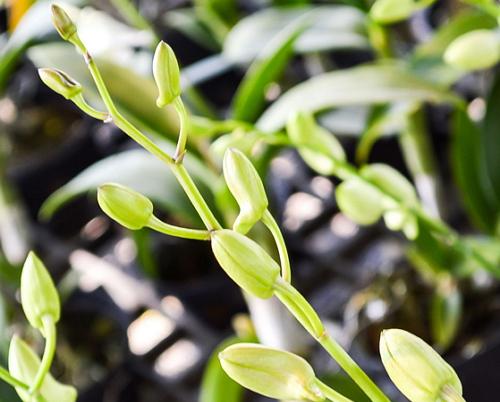

Dormant period in orchids
After flowering, the orchid begins a dormant period when it begins to accumulate strength for a new flowering. Leaving at this time is no different from leaving during other periods. The flower still needs good watering, high humidity, adequate lighting, and regular prophylaxis against diseases and pests.
As for dressings, their frequency and volume during the rest period should be reduced. If there is a need to transplant an orchid, then it's time to do this procedure right now, when the plant is no longer blooming.
A transplant is necessary if roots stick out of the drainage hole, or the soil dries out quickly after watering. As a rule, the need for this procedure appears after 2-3 years.
Are orchids suitable for cutting?
What could be more beautiful than a bouquet of orchids? But these flowers do not live long, and not every species is suitable for cutting. Let's try to figure out how to prolong the life of an epiphytic bouquet and which orchids to choose.
Phalaenopsis, cymbidiums and pafiopedilums can stand in a vase and retain freshness and aroma for several weeks (and sometimes a month). Other orchids run the risk of not standing for an hour, literally withering before our eyes.


If you are purchasing cut orchids, look primarily at the petals and sepals. They should be shiny, as if covered with wax, and tough - then the orchid will stand for a long time.
How to extend the life of a bouquet of orchids:
If the flowers were brought from the store, then they need to update the cuts. Cut the stems obliquely. The procedure is recommended to be carried out under running water. It is advisable to update the slices every 2-3 days. Water for keeping cut orchids must be soft and clean: you can use boiled or filtered water. It needs to be refreshed periodically by adding fresh one. Cut orchids, like potted home orchids, are afraid of too high and very low temperatures. It is also recommended to protect them from drafts and bright sun.
Orchid care FAQ
Here I will try to cover as fully as possible the basic questions of orchid care that every novice orchid grower faces and thereby save your time looking for an answer on various resources on the Internet.
For ease of use, all questions are divided into four blocks:
What to do after flowering?
What to do with a flowering shoot after an orchid has flowered depends on its condition.
- If, after the flowering of the orchid, the peduncle turns yellow and dried, it should be cut off at the base and sprinkled with cinnamon powder, crushed activated carbon or wood ash.
- If only the apical bud dries up, it is better to cut the branch with it to the first lower bud.
- If the peduncle is intact, it has a green tip and dormant buds, then nothing should be done - after a while new flowers may appear on it.
Read more about how to prune Phalaenopsis after flowering here.
We suggest watching a video on what to do with a peduncle after the orchid has faded:
The peduncle is very important for phalaenopsis, therefore, during the period of its growth, it is necessary to take particular care of the plant, and in case of problems, to be able to correctly solve them.
If you find an error, please select a piece of text and press Ctrl + Enter.
Peduncles can grow in the most interesting way: sometimes they bend like a pig's tail, and then rise sharply. In addition, the shoot can grow in any direction - in this case, it is necessary to organize a support for the escape.
It is sometimes difficult for beginner growers to distinguish a peduncle from a root. Let's see what are the differences between them.
First, the shoot has a pointed tip, and the root has a rounded and blunt tip. Secondly, at the very beginning of growth, the peduncle has a complex structure. On the shoot, the rudiments of future scales are visible. The spine is absolutely smooth.
What to do to:
The arrow hasn't stopped developing?
So that the arrow grows and does not slow down in growth, you need to watch for the main parameters of care:
- Lighting - if it has decreased for natural reasons, it is necessary to introduce additional lighting with the help of illumination with special lamps for plants;
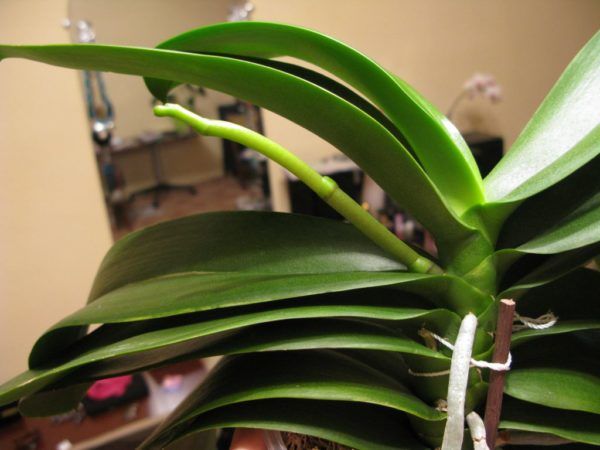

In order for the flowering arrow to grow well, all care conditions must be observed.
Observing these rules, the plant will certainly delight its grower. beautiful tropical flowers.
Did the orchid release several flower stalks at the same time?
How to make an orchid release several peduncles? More than 3 peduncles orchid will not release... More often, one shoot is released, on which flowers bloom.
But if the flower is old enough and has 8-10 leaves in its outlet, then there is a probability of 2-3 peduncles appearing.
But this is stress for the plant and sometimes after such an abundant flowering, there is a breakdown in orchid plants. But in our conditions, which are often created even by experienced florists, more than 2 peduncles do not appear on flowers.
Description of appearance
Unfortunately, on the territory of our country, the cultivation of indoor orchids is a completely new hobby. Orchids are beautiful and exotic plants for our latitudes, and many flower growers are concerned about what needs to be done during the period of peduncle growth. To navigate the flowering of such common types of indoor orchids as Cymbidium or Phalaenopsis, as well as less popular orchids, some features of this process should be taken into account:
- Orchid flower stalks often grow in the most bizarre ways. The peduncle can bend into a pig's tail, then begin to rise and grow upward. In addition, the peduncle can grow in any direction. While the flower stalk of a room orchid is growing, the grower should not touch anything. In no case should the plant be transplanted. It should be remembered that the peduncle always grows from the point of growth.
- As a rule, it is not difficult for experienced florists to distinguish flower stalks from the root, but an inexperienced florist cannot always immediately determine whether a flower stalk is growing in a room orchid or this part of the plant is a root.
- There is often a possibility that indoor orchids, after a short rest, and some types of orchids, will prolong the peduncle even without rest.


- The very beginning of autumn is the most favorable period for the flower buds of a room orchid to give rise to growth for new peduncles. This rule primarily applies to the species "Cymbidium" or "Phalaenopsis".
- If an indoor orchid simultaneously releases a peduncle and a new healthy leaf, then it is imperative that the plant make its own choice of what to develop further.
- Orchids from the "Phalaenopsis" species often have new leaves in summer or early autumn, and high-quality flower stalks are formed in late autumn.
- Long peduncles of Cymbidium orchids are known to many for their large flowers, which can often be bought in the cut. During the flowering stage, Cymbidium orchids should be kept in an evenly moist substrate, but not transplanted.
- Cymbidiums and Phalaenopsis are the most popular orchids today. Their reproduction is not difficult, and enchanting flowering can be seen in numerous photographs of amateur flower growers. "Cymbidiums" and "Phalaenopsis" are unpretentious not only at the breeding stage, but also undemanding to care.
Aerial root and peduncle: what are the differences
It is possible to determine which process a plant has by several signs.
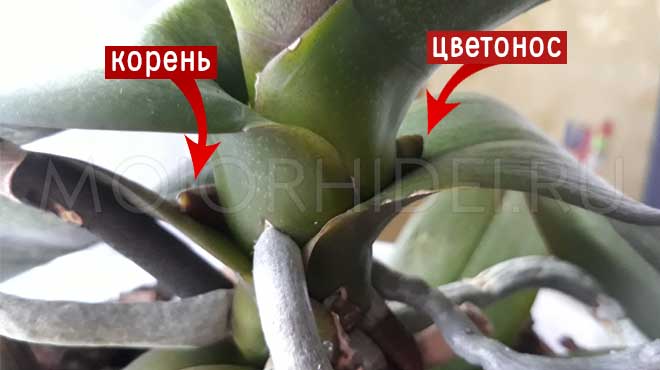

They are as follows:
- First of all, you need to carefully examine the flower and understand where the hatched shoot appeared. As for the new peduncle, it is often formed in the sinus of the leaf plate. In order to be clear, it must be said that it is a small angle between the "organ" of the plant and the stem. Such a place is ideal for the development of a flower bud. Experts note that the aerial root is "born" near the neck of the underground part of the orchid between other components.
- Besides, great attention is paid to the form. It is possible to recognize whether a root or a peduncle has appeared by the tip of the appendix. At the aerial root, it is rounded and at the same time blunt, and at the peduncle it is pointed.
- Another feature is structure. At the very beginning of its development, a baby may look unusual. Sometimes small scales are visible on its surface. In turn, the roots of Phalaenopsis are smooth and even.
Important! If there are any doubts and the gardener still does not understand how to distinguish a peduncle from a root, you can take a photo by showing it in a flower shop or write a comment on this article and we will help you find out.


Some beginners believe that the peduncle is necessarily lighter green in color, and the root is darker, but such differences can not always be seen.In this case, it still depends on the orchid variety. Therefore, first of all, pay attention to the place where the process appears and its shape..
However, any attentive florist will be able to figure it out himself. You need to know that flowers always appear from the axils of the leaf plates. Sometimes a small dry twig can be observed there, which is an undeveloped color. It often grows in parallel with the new peduncle.
If not one arrow appears on the phalaenopsis, but several, then attention is paid to their placement.
There are times when the color does not hatch in the leaf axils. True, this is more of an exception. In this case, the flowers appeared on the children, which formed where they found a place and at the same time, without separating from the main bush.
In conclusion, we show a photo of how this peduncle developed and grew.
Also watch a video that will clearly show the differences between a young root and a peduncle.
It is possible to determine whether a peduncle or a root has appeared on an orchid, only by a number of signs that indicate this.
Poor plant care and consequences
- It so happens that the owner of the flower does not have enough time to take care of it at the proper level.
- Also, it is not always possible to create ideal conditions for the orchid to throw out the peduncle.
- Improper care can lead to the appearance of different types of parasites: worm, spider mite, whitefly, thrips.
The most common illnesses associated with poor orchid care are:
- RotIs a type of fungal disease. All affected areas are urgently removed, and the sections are disinfected.
Orchid is an exotic flower that requires special attention. Proper care - guarantees regular and lush flowering, disease-free, healthy appearance of the plant.
Care during the growth of the peduncle
For flower growers, there is an unshakable rule: during flowering, do not touch the shoots in any case. All the more, we are not talking about a transplant. The peduncle always grows from the point of growth. If suddenly the orchid decides to release a peduncle and a new leaf at the same time, then the choice must be left to the plant. It will decide itself what to develop further.
Did your orchid flower in the fall? By following simple procedures, you will prolong your lush bloom well into the New Year. During the period when the peduncle is forming, locate the plant in the brightest place. These may be windows facing south, because the sun is no longer so hot.
Since the orchid grows in its homeland under conditions of twelve-hour daylight hours, if no buds appear in November, the orchid needs to be provided with additional lighting. This will allow the beauty to fully blossom and delight those around her with her delightful charm.


The next condition is to continue watering as the soil dries out. Depending on the room conditions, the watering period will range from once a week to once every two weeks.
If you fed the flower before the bud begins to form, then continue until the first flower is born. Then stop fertilizing the soil.
The peculiarity of the orchid is that the emerging shoot already contains the number of flowers intended for flowering. Therefore, fertilizers can no longer increase their amount, but the opposite effect can occur.
The plant can drop all flowers unexpectedly. Therefore, the rule for feeding orchids is to apply fertilizers before the buds form, and not during the appearance of flowers.
Pruning methods
Many growers do not know what to do with the flower stalk of a room orchid immediately after the end of the flowering stage. In a good flower shop, buyers are often consulted not only about the peculiarities of caring for certain types of indoor plants, but also, if desired, by a florist explain how to properly cut a peduncle from a room orchid of a particular type or transplant a plant.
To make pruning less traumatic, it is advisable to pay attention to the photo describing the features of caring for a particular type of orchid plant. In addition, pruning must be done according to certain rules. The basic rules for competent pruning of the peduncle in the care process are as follows:
- after the peduncle of a room orchid dries up, it should be carefully trimmed;
- pruning should be done with a clean and sharp tool, and after pruning, a stump should remain on the plant, no more than 2 cm in height;
- the cut points of the peduncle should be slightly dried and then treated with a special composition based on activated carbon;
- if the peduncle of a room orchid grows after the end of the flowering process, then after a while new buds or so-called "babies" with a root can form on the shoot, which make it possible to transplant new plants.
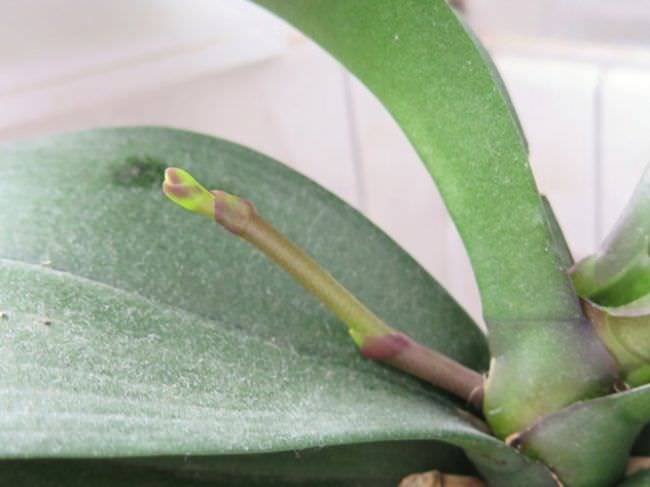

It is extremely important to choose the right time and stage of plant development to remove the peduncle. Pruning orchids is not always successful. In the presence of "dormant" buds, it is recommended to trim the peduncle slightly higher than them, which will be more correct to maintain the health of the plant.
Orchids can rest a little, and then start up new flower-bearing shoots again. This is done, as a rule, by almost all orchids adapted for growing and reproduction at home.
Possible problems and solutions
It happens that the peduncle either grows somehow "incorrectly", or is absent altogether.
Unfortunately, injury to the plant is also possible when the arrow breaks. For newcomers, such abnormal situations cause a lot of excitement.
There is no need to panic. We will deal with each of these cases and consider what a florist should do.
Emergence from the point of growth
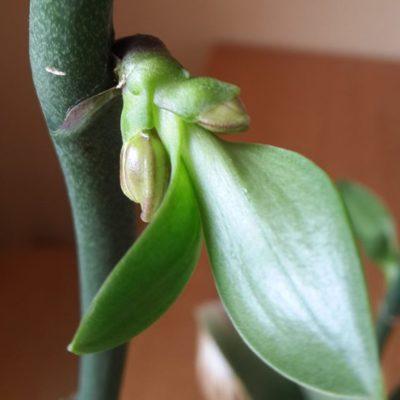

The arrow grows from the point of growth - this happens with older phalaenopsisthat have experienced many flowering cycles. Another reason is the severe stress experienced by the plant. This is the very case when the owner of the plant does not need to do anything. Just take care of your pet as usual. Perhaps the arrow will still give buds or a baby.
The flower-bearing shoot broke
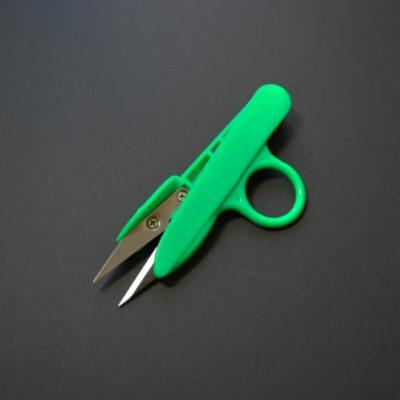

What to do? Just cut the peduncle to the kidney closest to the fracture site, and process the cut site - dust it with activated charcoal or cinnamon powder. In no case try to connect the fragments with tape or tape, as some inexperienced amateurs try to do, in the hope that their orchid will "grow together". This will only harm the plant, it may begin to dry out!
Not at all
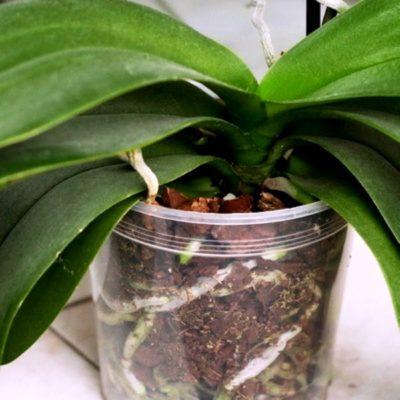

What should the owner of a "lazy" phalaenopsis do, how to grow a peduncle after all? If the plant is not in a hurry to pasture the arrow, you can give it a slight shake-up - place it in a darker than usual place and water it less often than before (of course, without bringing it to complete drought). If possible, at night it is better to lower the temperature for phalaenopsis by 5-6 degrees... Experienced florists make plants that sleep for even a year or more in this way.
Stopped in development
It happens that the peduncle grows to a sufficient length and even gives several buds, and then suddenly stops growing.
Esdi phalaenopsis stopped growing action algorithm:
- First of all, you should make sure that the orchid is healthy. Perhaps the reason is some kind of disease or pests.
- Analyze the conditions of keeping your phalaenopsis - is there enough light for it, is the mode of humidity and temperature observed, is there enough feeding for it?
- If, after treatment and the establishment of optimal conditions, the peduncle continues to remain frozen, the most reasonable thing is to take expectant tactics and observe the arrow. If it has not dried up, there is a chance that the green friend will someday please you with flowers.
You can find out more about the main reasons for the lack of flowering of phalaenopsis here, and from this article you will learn how to make an orchid bloom at home.
Post-flowering actions
When the flowering period ends, the care of the flower depends on the condition of the flower stem. When yellowing and signs of drying of the shoot, it is cut off at the very base. To prevent the penetration of infection, the resulting wound is sprinkled with crushed coal or ground cinnamon. For the same purpose, you can use chalk.
When the stem itself is green and the apical bud is dry, the stem is shortened. The cut is performed slightly above the first living kidney. Open tissues are treated for disinfection with cinnamon, charcoal or chalk.
If the stem shows no signs of wilting or withering, it is green with healthy buds. After the end of the dormant period, buds form again on such a stem and flowers bloom. Therefore, you do not need to do anything with it.
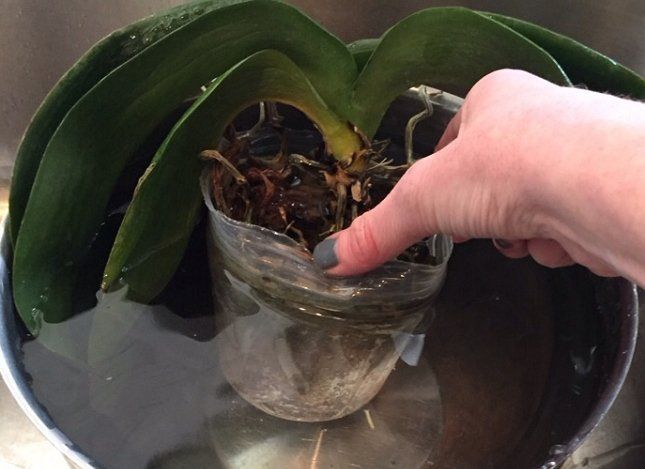

How to prevent a stop in arrow development
When a peduncle has appeared on the plant, it is important to create comfortable conditions. Then the arrow will constantly develop and will not stop developing. For this, it is important to ensure that the lighting does not dim. If the duration of daylight hours is reduced, additional lighting with phytolaps is organized.
Watering gradually decreases and increases the interval between them. In this case, it is important not to overdry the plant. The room temperature is kept at an optimal level for good vegetation. Fertilizers are applied on time in accordance with the attached instructions.
Orchid awakening period
Any plant has a period when it needs rest. This usually occurs after flowering. In orchids, the dormant period is either pronounced or not quite. If in natural conditions awakening begins with the arrival of warm weather and heavy rainfall, then it is quite difficult to create a natural, natural climate at home.
It is biological or forced reasons that are the determining factors in the severity of dormancy and awakening of the plant.
Heat and moisture intake with nutrients provokes active vital activity of the root system, which stimulates the formation of a new life - the awakening of a sleeping bud, and from it - a peduncle or a baby.
therefore the main period of awakening is the spring seasonaccompanied by an increase in ambient temperature.
Growth characteristic
In the phalaenopsis orchid, the peduncle appears when ideal conditions are provided for it. Only then will he decide to bloom. If the place or microclimate does not suit him, then he can stand for years and never release the arrow.
Conversely, under favorable conditions, it is able to bloom several times a year, with a total duration of up to 8 months. Therefore, if your plant is not blooming, reconsider how you care for it.
It takes a lot of time for an orchid to grow a peduncle. On average, this process takes 1-2 months. It also takes a lot of time for flowers to bloom on a grown arrow. In total, from the appearance of a sprout to the blooming of flowers, it can take from two to three months. The more difficult the conditions for the flower, the longer the growing period.
When and how
An orchid, unlike most indoor plants, does not have a specific flowering time. They give arrows both in winter and in summer. If only there were suitable conditions for flowering.
What is meant by the conditions for an orchid? First of all, it is the temperature regime and daylight hours. The orchid requires a temperature of at least 22 degrees to enter the flowering phase. However, fever over 30 degrees is already contraindicated.
Daylight hours should be at least 12-14 hours. If the natural daylight hours are shorter, then in order to stimulate the growth of the peduncle, you will need to illuminate the plant with a special lamp.
Room humidity is also important.It should be about 50%. But this is only on the outside. But in a pot, the substrate should be watered regularly. But do not forget that the roots of the orchid do not tolerate excessive watering well.
Providing the flower with all these conditions, and a good place on the window in the shade, you will ensure flowering at any time of the year. At the same time, you need to know that the duration of flowering depends on the observance of these rules. The orchid can bloom and soon shed flowers and buds. Or it can stand smartly for up to 4 months in a row. And this period depends only on you, and on the conditions of detention and microclimate provided by you.
It will begin precisely with the appearance of a small process. After some time, it is already possible to recognize a peduncle in it. This is usually possible within a week. In a month, it usually grows almost completely. And the same amount will be required for the formation of buds.
How many there are usually
Typically, the plant will only release one arrow at a time. However, there are cases when additional peduncles grow. This usually happens when a large amount of dressing is applied.
From a decorative point of view, multiple stems are a wonderful phenomenon. After all, the more arrows, the more colors. However, in nature this is not characteristic of the orchid and carries a risk for it. Each peduncle and flowers on it require a large amount of nutrients and moisture. The root system of the plant will not always be able to cope with the double load. Her inner strength can be depleted, and her reserves of energy and nutrition can be significantly depleted.
Considering that with each subsequent flowering of the orchid, the peduncles will form more and more buds, it is worth considering the advisability of stimulating the growth of additional peduncles.
Step-by-step instructions on how to get a smooth escape
Like flowers of other plants, an orchid shoot tends to light. Sometimes this causes some inconvenience, since the arrow turns out to be uneven. In addition to the aesthetic component, the crooked peduncle makes care much more difficult. The pot with an orchid loses its stability, and under the weight of the flowers it can repeatedly topple over.
To grow a straight and even shoot, you need to perform a number of activities.
The easiest way is to rotate the flower pot regularly. Turning it slightly in the same direction every day will ensure it grows evenly. Since the light will be from different directions every day, the arrow will not lean in any one direction.
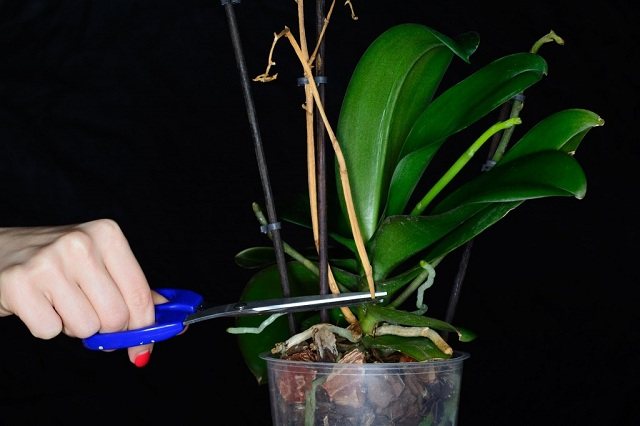

In addition, the grown shoot can be tied to a support. But for this you need to have some experience. Otherwise, you can, on the contrary, provoke the appearance of curls and curvatures on the shoot in the places of the garter.
Summarizing
An orchid is a tropical flower, so adaptation to unfamiliar conditions is not easy. If sprouts appear on the plant, it does not matter if it is roots or a peduncle: this means that the plant is full of strength and has fully adapted to its new place of residence.
If you treat the plant with love and care, carefully monitor its development and take care of it in time, it will delight the owner's eye with a magnificent beautiful flowering and an unusual aroma for a long time.
The necessary conditions
During the period of peduncle formation, the brightest place. Since the awakening of meristems usually occurs in autumn, depending on the region of growth, attention should be paid to the power of the sun's rays.
In more northern regions during this period, the sun is not so scorching and there is a possibility of placing orchis even on the southern window. If the sunlight is still strong, then it is necessary to place the orch so that it is diffused. But do not place it on the north side.


Orchids should be shaded from direct sunlight.
Before the main mass of flowers appear, the place cannot be changed., otherwise there will be a delay in the formation of buds from the resulting stress.The number of daylight hours during this period should not be less than 12 hours. If there is a lack of light, you should use additional lighting using a phytolamp.
Watering
Watering should continue as usual - be moderate. Depending on the growing conditions, the regularity of watering is carried out in different ways. This can be once every one, two, or even four weeks. The state of the substrate should serve as a guide.... After watering, it should dry completely.
Fertilizers
Those dressings that were made before the appearance of the flowering arrow continue to be applied in combination with watering. Feeding stops with the appearance of the first flower.
Fertilizers that were applied before and during the formation of the arrow determined the number of flowers on it. Excess can significantly shorten the flowering time.
Therefore, the introduction of additional nutrition is important before, not during flowering.
Features of reproduction by a peduncle
At home, orchids are propagated by:
- division of rhizomes;
- seedlings;
- kids.
At the same time, reproduction by children formed on the flowering arrow is considered the most reliable and loyal way to the safety of the plant.
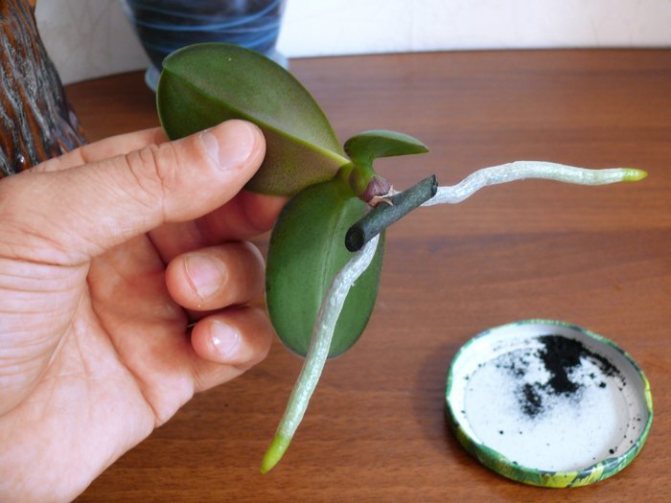

The following advantages of the method are noted:
- the mother plant is not injured in any way;
- the overwhelming number of seedlings take root;
- ease of use;
- the ability to independently wake up the kidneys.
But for the education of children, certain prerequisites must be created:
- the orchid must be an adult;
- she needs to have at least 4 leaves;
- its root system must be in a healthy state;
- the flowering period should have already passed;
- it is necessary to keep within the time interval between the end of winter and mid-summer;
- a fresh flowering shoot with a developed bud is required.
Read how to make an orchid bloom.
In addition, certain efforts are required on the part of people in the form of:
- ensuring daylight hours not shorter than 10 hours with diffused sunlight;
- creating daily temperature differences from + 25 ° С during the day to + 17 ° С at night;
- maintaining a stable humidity at 50%;
- termination of fertilizing with fertilizers.
The very process of reproduction of an orchid through a peduncle is as follows:
- A flower-bearing arrow with dormant buds is cut in such a way that a 3 cm-long shoot remains on the mother plant, which is then treated with crushed activated carbon every week for a month.
- The cut off shoot of the peduncle is placed in a transparent container with an activated carbon tablet at the bottom, into which soft water is poured to a level of 5 cm.
- To create a greenhouse effect, the container is covered with a transparent film and placed in a well-lit place at temperatures up to + 27 ° C.
- The water in the tank is changed weekly.
- When 3 leaves and roots up to 5 cm long are formed on the baby, it is separated from the flowering shoot with a blade.
- The separated baby is placed in a transparent container with crushed and moistened pine bark.
- The container is covered with a transparent film and placed in a sufficiently lit place, periodically moistening the bark.
- After the appearance of 2 new leaves, the film coating is removed.


How to grow an orchid from a peduncle
Undoubtedly, the simplest way of reproduction of the Phalaenopsis orchid is to transplant the lateral processes of the peduncle or the so-called “babies” with roots. With proper care, they grow very quickly and the transplanting process is absolutely simple. Already faded stems are also allowed to be used for the propagation of indoor orchids.
If the characteristics of the type of orchid plant allow propagation by a peduncle, then the standard method of grafting should be used. You should not be afraid to harm the health of the plant. Regardless of the state of the old peduncles, new shoots appear over time in orchids, and their growth is clearly visible in the photographs of these amazing plants.
podokonnik.
Orchid flower stalk
The peduncle is that part of the plant on which the buds will form and upon dissolution please your grower.
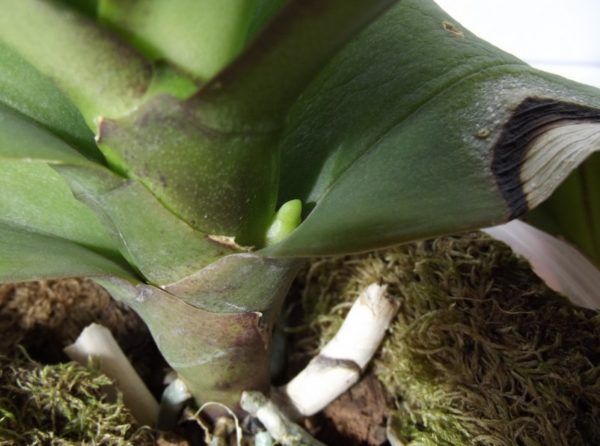

The flower stalk plays an important role in the life of the orchid.
If a flower shoot appears on the plant, then this state can be called the active phase of plant development. At this point, the plant must be fed with fertilizers intended for orchids. A photo of how orchids produce flower stalks can be seen above.
Description
At the time of appearance, the peduncle can be confused with other parts of the plant. Novice florist
wonders what
it appeared on his plant:
Possible problems
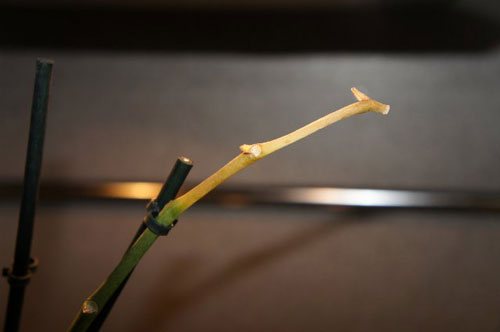

Sometimes in the epiphyte, the peduncle does not grow for a long time, or the arrow has grown incorrectly. Often, flower stalk breaks in flower growers with little experience. In this case, you need to understand the cause of the problem and determine the actions to solve it.
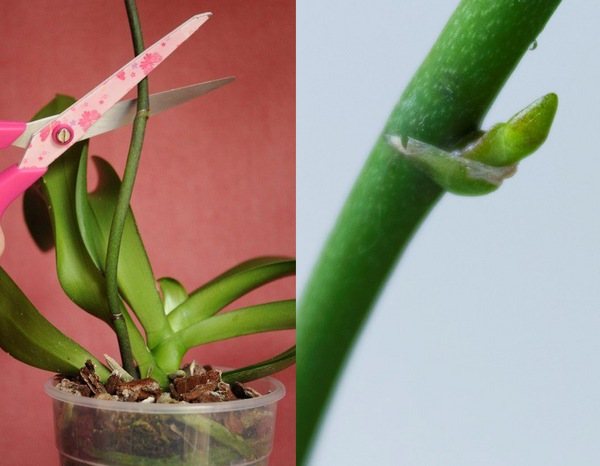

If the arrow has grown from the point of growth
This problem arises when growing older phalaenopsis, which have bloomed many times. Severe stress becomes another reason. After all, orchids are susceptible to conditions of detention. The owner needs to know that this situation does not need to be corrected. Such a plant is provided with the usual care. Perhaps, after a short time, new peduncles or children will appear on it.
If the flower-bearing stem breaks off
To correct this situation, the stem is cut slightly above the nearest healthy bud. The open area is treated with activated carbon powder or ground cinnamon to prevent infection from penetrating into open tissues.
Lack of flowering stem
It is not always possible to grow phalaenopsis so that a flowering stem is formed on it. Then the flower is shaken to speed up this process. To do this, the pot is moved to a darker room. At the same time, the amount of irrigation is reduced, but the substrate is not brought to complete dryness. If possible, the room temperature is reduced by 5 degrees at night. In this way, it is possible to wake up phalaenopsis that have been in hibernation for a year or more.
Stopping development
Sometimes in an orchid, the peduncle has grown to a sufficient length and formed several buds, and then further growth stops. Then, for recovery, the following actions are carried out:
- Carefully examine the epiphyte to make sure it is free of disease and pest infestation.
- If everything is in order, they analyze under what conditions the flower is contained. He should have enough lighting and nutrients, heat and humidity.
- If, after changing the growing conditions, the flower stem still does not resume its growth, the most reasonable solution is to observe the plant. After a while, the not withered arrow will surely start growing and will delight you with flowering.
Differences between a peduncle and an embryo
In addition to the roots and peduncles, orchids form the embryos of new flowers, or, as they are also called, "babies". They mainly appear on the pedicel, but there are times when they grow near the root of the plant. In this case, the embryo is just as easy to confuse with a peduncle.
At the beginning of development, babies have the same shape, a similar stepped stem structure and do not even differ in color. Some signs help to understand that a fetus has appeared:
- the sprout has no point of growth;
- a leaf appears instead of an arrow;
- the plant is more than 5 years old.
If you look closely at the process, in addition to the similarity, you can also see some differences between the peduncle and the baby. The shoots look the same only at the very beginning, as the peduncle grows, it stretches and grows upward, and the baby takes the form of a droplet with a characteristic depression in the middle of the shoot.
As it grows, the peduncle retains the stepped structure of the stem, while in the embryo, the scales are much smaller and do not develop during growth; after 10-12 days, the peduncle becomes longer, and the embryo releases 1 or 2 leaves.
It will not be difficult to distinguish the root of a flower from a peduncle if you know the characteristic features of each of the elements presented.
How to revive a dried peduncle
If the peduncle of the orchid dries up or has already dried up, then it should be carefully trimmed. It should be remembered that after the flowering stage, the orchid shoot-peduncle fades and can either dry out or continue to grow further. If the peduncle is slightly dry, but remains dense, then it is advisable not to cut it off for a while. It is imperative to wait until the stalk is completely dry.


Florists often wonder what needs to be done with the peduncles from which the flower buds have fallen. These plants should be watched for some time. The main condition is compliance with proper care, and then, after a few months, the indoor orchid will bloom profusely again and will allow you to take bright and colorful photos.
Why is it important to distinguish the arrow from other parts?


A new root, baby or peduncle portends a lush orchid bloom... Every flower lover should be able to distinguish a peduncle from other parts.
It is important that:
- Prevent flowering of a plant that has survived planting or illness. The shoot is cut to give strength for growth.
- Observe the development of the orchid.
- Understand how to properly care for an orchid during flowering.
If the plant simultaneously releases a healthy leaf and peduncle, it needs to be given the opportunity for further development.
What does it look like?
The peduncle changes greatly during the life cycle.... It can be of two types: just appeared and old. A young shoot grows from the place where the leaf comes close to the stem - from the bosom.
Such a peduncle is different:
- Rich light green or green color.
- Growing up or sideways towards the sun.
- A flat shape with a pointed end of a stepped shape.
On a young peduncle, you can see scales... From the moment the arrow grows to the opening of the buds, it will take about 2 months.
Over time, the flowering arrow will develop and develop into a succulent, long and flexible stem. Buds will bloom on it.
Then the old bud dries up and falls off. It is advisable not to allow this, but to cut off the shoot after the last flower withers. Such a measure will help keep the plant strong.
Pay attention to the tip of the peduncle... It is often difficult to know if the flowering time has passed. If the bud is green, it can grow and bud. When the tip turns yellow, blackened or dried out, the flowering period is over.
Each grower decides for himself whether to cut or leave a peduncle. Old shoots weaken the plant and retard the development of new shoots. But the old peduncle can form babies or bloom again.
How to distinguish from root and baby?
The newly appeared arrow on an orchid can easily be mistaken for a root or a baby.


The peduncle has a number of distinctive features.:
- Grows from the leaf axils of a fresh leaf.
- The sharp end of a complex stepped shape, like a cone. It resembles a closed beak.
- Pointed upward, sometimes sideways.
Down the peduncle will begin to descend only under the weight of the formed buds.
The root usually grows next to others - under the leaves at the base of the trunk. But it can appear in an unexpected place - to break through the leaves. The root has a rounded, smooth obtuse shape, no scales. As it grows, the difference between the tip and the rest of the root will become noticeable. It will be gray or gray-green, and the bright end will be light green or green. The root bud can grow in any direction, but is usually directed downward.
Peduncles and roots are slightly similar only in the initial stage of development.... Upon careful analysis, it becomes clear that they are completely different. There will be one fact to unite both parts of the plant - during germination, they seem to break through the leaf.
It is almost impossible to determine immediately whether a flower-bearing arrow or a baby has appeared on an orchid.
What a new baby looks like:
- Pointed up.
- The shape of the tip resembles an open beak.
- Grows in the place of flowering shoot.
The appearance of the baby (including the root one) is preceded by a complete absence of a growth point. Instead of a leaf, there is an arrow from the top. Moreover, the orchid is quite old - over 6 years old.
The baby has a number of differences from the peduncle:
- Very small scales that hardly develop during growth.
- After two weeks, the arrow grows and releases leaves.
- As the process develops, a depression forms in the middle.
The ability to immediately recognize new growths on an orchid will come with experience.
We offer you to watch a video on how to distinguish an orchid flower stalk from roots and children:
Stimulation of peduncle formation
If the flowering of the plant does not occur for a long time, then you can try to stimulate the distillation of a new shoot-peduncle. You can make an indoor orchid bloom again. It is not difficult to carry out such an event. With a few fairly simple tricks, you can stimulate an indoor orchid to release a new peduncle and bloom profusely.
However, it should be remembered that it is impossible to make a plant bloom without creating optimal temperature conditions and proper care. There are two ways to stimulate a houseplant to bloom again. As a rule, it is possible to stimulate the re-formation of the shoot-peduncle as a result of a little stress:
- artificially cause the plant to feel drought, minimizing as much as possible, and sometimes completely stopping watering after flowering;
- in the process of leaving, achieve re-flowering with sharp temperature fluctuations.


Both methods are well demonstrated in photographs with a detailed description of the technique. It is best to stimulate the flowering process in winter.
Caring for the plant before and after the arrow appears
Cultivation of a flower before the emergence of a shoot goes the standard way:
- Lightingshould be absent-minded... It must be remembered that already in April the flower is removed from the sill of the southern direction;
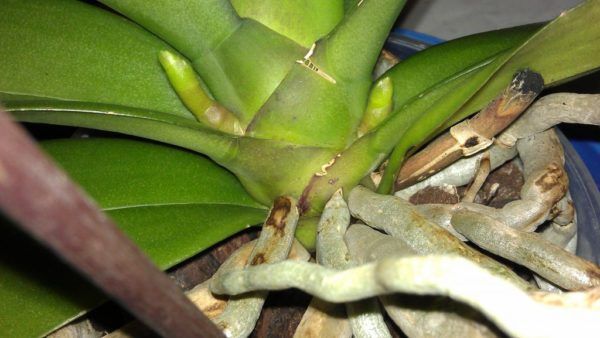

In order for a healthy peduncle to grow, it is necessary to create suitable conditions.
When a flower shoot appears conditions change slightly and you need to pay attention to the parameters described below for caring for an orchid.
Reducing the watering regime
Watering starts to cut backas soon as the arrow starts to develop. But this does not mean that the flower should be dried out.


When a peduncle appears, it is necessary to reduce watering.
It is just that between watering we leave not 2-3 days of drying, but 5. That is, if the watering was once a week, now it is watered once every 2 weeks.
Features of applying dressings
When a flower shoot appears dressing slightly reduces... And when the buds begin to form, they stop altogether. Because top dressing will greatly shorten the flowering period.
Lighting and temperature
If the arrow began to form in the autumn-winter period, the flower located on the windowsill in the southern direction... If it is not there, then you need to take care of additional lighting, since the shoot will not develop without sufficient lighting.
Indoor air temperature for proper development should be within 23-26 degrees Celsius... Cooling may well slow down development and, if measures are not taken, the shoot will begin to dry out.
The difference in flower care before and after the arrow appears
Before the peduncle appears on the phalaenopsis, you need to adhere to simple rules:
- provide sufficient, but diffused lighting (avoid the south side of the premises);
- water the plant regularly (do this only after the top layer of the soil has dried);
- place the flower pot in a well-ventilated room, but so that a draft does not form there;
- it is necessary to moisten not only the soil, but also the air around the phalaenopsis;
- orchid feeding should be regular, comprehensive and complete.
When the flower arrow appears on the horizon, you will need to slightly change the conditions of the plant. To do this, change:
- Location.
If the flower stalk is released in mid-autumn or at any winter or spring time, place a flowerpot with a pot on the south side of the room. Do not be afraid, during these periods the sun is not so hot and will not harm the flower. Watering mode.
It needs to be shortened a little. But you have to look at the situation. Ingoda has to be watered only once every two weeks (compared to what was previously watered every seven days). Top dressing mode.
As soon as the flower arrow appears, you will need to reduce the amount and frequency of fertilization, but only slightly. But after the peduncle has already gotten stronger and grows up, and swelling buds begin to appear on it, you need to end the feeding process. The fact is that the abundance of fertilizers will no longer affect the number of flower buds. Their number is laid even at the stage of the formation of the peduncle itself.
How to care for an orchid after it has released a peduncle, read here, and from this article you will learn about what to do with a peduncle after the arrow has faded and how to care for the plant.
Why distinguish between orchid root and peduncle
It is important to learn how to correctly determine what kind of sprouts appear on the plant. This can be a signal that he needs more careful care.
The orchid during the flowering period requires special care and requires special attention. From time to time, it needs to be fed with fertilizers and the irrigation schedule should be changed.
There are times when the plant should not be allowed to bloom. For example, if it hurt for a long time (roots began to rot) or recently underwent a transplant, and the adaptation period was difficult. In such cases, the best way out is to cut the stem of the peduncle, thereby preventing the plant from blooming. This will help the orchid conserve energy and use it to grow. Blooming requires a lot of energy from the flower.

